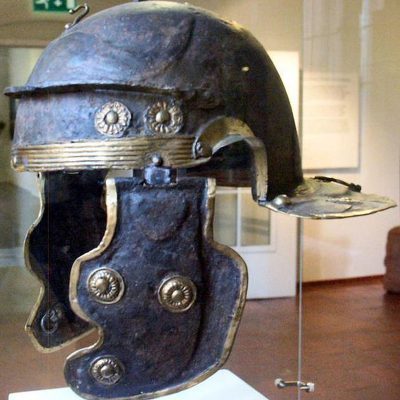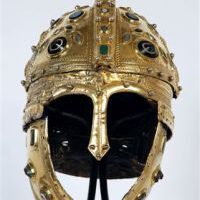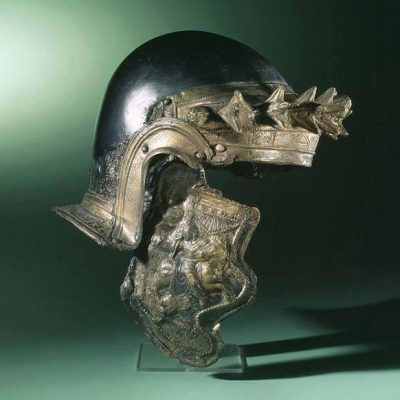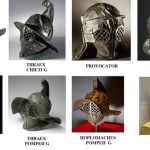Chapters
Initially, the Romans used Gallic helmets, hence the name Galea (full name cassis-galea). Then they started mass-producing their own helmets (cassis). This was due to the professionalization of the army (more or less from the time of Marius’s reform), in which efforts were made to unify the offensive and defensive armaments of the legionaries. This also applied to helmets, which underwent numerous changes and modifications resulting from the use of materials and production techniques as well as functions (helmets of legionaries, helmets of auxiliary units, cavalry helmets).
A Roman helmet (cassis) protected the head of a Roman infantryman, tied under the chin with a leather strap. It was made of leather covered with a metal sheet.
The top of the helmet was strengthened by knobs, rings or a button made of metal that served decorative purposes. On the sides there were movable cheek visors (buccula), which were connected with each other with a thong, tied under the chin. A neck protector was attached to the helmet.
Legionnaires wore shawls or scarves around their necks to prevent the armor from rubbing against the naked body. The legionary’s helmet was decorated with a plume with short feathers (iuba or crista), usually during parades or at times when it was necessary to impress the enemy. Their combs were usually parallel from ear to ear.
Centurions and senior officers wore helmets with three feathers (crosswise comb) or a horse’s mantle.
During the march, the helmets were worn on the right side of the breast, on a thong placed around the neck. During rest or camp work, the helmets were hung on shields placed on the ground.
Types of Roman helmets |
|
Montefortino helmet
Initially, the Montefortino type helmet was used, which was used from the 3rd century BCE to the 1st century CE. These helmets were made of brass or bronze with a convex shape, with a small elongation at the back of the neck. They usually had a plume plug on the tip of the helmet. The Montefortino helmet was derived from the Celtic style. During this time, it was constantly modified. An example is the Hagenau type helmet, which still has the typical shape of a Montefortino, but the protection of the neck has been significantly expanded, the arch above the eyebrows is reinforced, which allows the helmet to be worn more freely when it is not on the head. The soldiers additionally protected their cheeks by wearing metal plates attached to them.
Initially, Roman helmets of this type were heavily decorated, which was due to the fact that the armaments were provided by the citizens themselves while fighting. With the Marius reforms at the end of the 2nd century BCE, armaments were mass-produced and the helmets’ appearance was standardized.
The name of the helmet comes from the Montefortino region in Italy, the place where the first piece of this type was discovered. The find was in a former Celtic burial ground.
Coolus helmet
In the times of the reign of Augustus mass-produced, cheap and simple in design Coolus helmet appeared in as many as nine modifications from A to I. It was actually a copy of the Gallic helmet to which the neck, brimstone and cheek pads were added as a typical Roman distinguishing mark.
The browband was in the form of a metal plate forged from one piece, which additionally strengthened the helmet bell from the front, protecting it against cuts from above. Of course, this had a very practical application. A damaged and cracked headband could be easily replaced while the bell remained intact. The cheek pads, movable on hinges, appropriately contoured, protected the face against cuts from the sides.
However, they left the eyes, mouth and ears exposed, thus enabling visual and verbal communication. The neck is sufficiently elongated and inclined at the right angle, although in the first varieties of Coolus it is completely straight, it protected against attacks on the back of the head and neck. Effective protection against both infantry and enemy cavalry.
The coolus helmet has been replaced by the Imperial helmet.
Gallic imperial helmet (galea)
The best plants to produce iron helmets were in Gaul. With its conquest by Julius Caesar, these factories and the craftsmen working in them became part of the Roman Empire. This fact is related to the introduction of another helmet, probably the most characteristic of the Roman military the so-called imperial-Gallic (varieties A through K).
The helmet had a deep bell with walls almost vertical at the bottom, brimstone and above it wavy protrusions, the so-called eyebrows, on the back a large cap with a carrying handle, and above it the so-called folds. The face part was covered by the cheek pads at the front with openings for the eyes and the mouth at the back for the ears. The number of eyebrows and folds, the angle of the nape and the profile of the cheeks differed from one type to another. These helmets could be decorated with brown rosettes on the cheeks and forged with narrow bronze stripes on the edges.
Some of the helmets used by legionaries had a comb holder. The comb was usually made of a plume or horsehair. Legionnaires with the red color of the comb appear most often in pop culture. Probably, however, this ornament was not only red, but also yellow, purple or black, and in a combination of different colors. Written sources (e.g. Vegetius) or sculptures indicate that the combs were worn longitudinally by ordinary legionaries when the centurions mounted them transversely. The practice of centurions wearing combs spread throughout the early empire; later, such combs were worn only by legionaries and centurions at military parades.
Imperial Italian helmet
In the late 1st century BCE, the legions were equipped with another type of helmet, the so-called Italian imperial helmet with its eight modifications from A to I. Initially made of bronze. It referred to the local Samnite and Etruscan traditions, but also had Gallic features. It did not have the so-called eyebrows, may, in some variants, have mounts for putty and plumes made of horsehair. It had movable cheek pads and a large neck. Characteristics for this type of helmet are often appearing decorations in the form of brown appliqués, e.g. houses on the cheek pads or the so-called aedicula on the bell or cartouches (tabula ansatae) and inscriptions with the name of the helmet owner, affiliation to a specific military unit.
In general, the Imperial-Italian helmet type is very similar to the Imperial-Gallic helmet type. However, it differed in greater simplicity of execution, less decorative character, and was probably produced in Italy. It was in use until the beginning of the 3rd century CE. The earliest specimens come from the Herculaneum, which may suggest that this type of helmet could have been worn by city or praetorian cohorts.
Dorsal helmet
In the late 3rd century CE, there was a complete break with the previous types of helmets, which were largely based on the Celtic style. The new Roman armament was based on Sassanid and Sarmatian helmets.
The dorsal helmet was made of more than one element. There was a two-layer or four-layer one, with a characteristic comb in the middle, and small cheek pads hanging on the sides. Many surviving specimens also prove that some helmets had nose protection. An example of a dorsal helmet was found at Intercisa, Hungary, in a dug hole full of 15-20 different helmets. The object was distinguished by height, integrity and an iron crest.
Most of the extant dorsal helmets have decorative elements made of silver-plated iron or some other form of silver or gold plating. A perfect example of a richly decorated helmet is the one found in Deurne (the Netherlands), which has a silver-gold plating and was supposed to belong to a rider with equites stablesiani. A richly decorated dorsal helmet was also found in Novi Sad (Serbia); this one also has decorative jewels.
The earliest image of a dorsal helmet is seen on the coins of Constantine I and it is believed that their first use dates back to 270-300 CE. The latest representations of the use of a dorsal helmet can be found on the coins of Constantine III from 409-411 CE.
Helmets of other Roman units
Regular Roman infantry was accompanied in the same number by auxiliary units, the so-called auxilia, recruited from conquered tribes and all those peoples who did not have Roman citizenship, but was skilled in the military craft and brave they wished after completing After thirty years of service, obtain such citizenship. Apart from the amount of pay, the units of these organized cohorts differed in equipment. Briefly and simply, it was a cheaper and simplified copy of the equipment of regular legionary infantry. Therefore, the helmets of auxiliary departments deserve separate treatment. The auxiliary infantry helmets (available in four varieties, A to D) were much simpler to build and devoid of ornamentation. Most often they imitated Coolus or Imperial-Gallic helmets. They had a band collar, a neck and mobile cheeks. Sometimes they were given cross-bracing, riveted to the bell (Type C). This invention appeared during the so-called Dack wars (101 – 106 CE) during the reign of Trajan. It proved to be effective against Dacian scythes (rhomphoi) mounted vertically on a shaft. Such helmets were made by a method known today as drift or manual spinning. The desired shape of a rotating figure was obtained from a disc-shaped piece of metal turned on a wooden or metal mold. A large force was needed to perform, probably obtained by means of the so-called water wheel.
The helmets of archery units mostly of eastern origin had conical shape resembling the old Assyrian helmets, but with typical Roman accessories such as cheek pads and neck caps, sometimes made of scales or lamellas attached to fabric or leather.
The auxiliary units also included cavalry squadrons (Cohors Equitata). The first truly cavalry helmet (classified in nine variations A to I) appeared in the first half. 1st century CE Cavalry helmets were basically based on legionary infantry helmets, with the nape of the neck much extended downwards. Such a helmet had cutouts for the ears and flared cheeks, quite tightly hiding the face, except for the eyes, the nose, and the mouth. Perhaps it was the cavalry helmets that underwent the most visible changes. In the first half of the 2nd century CE, an impressive deep iron helmet (type E from Hedderheim) was introduced with a cross-reinforcement on the bell attached with pointed rivets. He had large cheek pads covering his ears and a jaw that was fastened with a hook. Due to their depth, the necks and cheek pads rested on the rider’s shoulders. However, this was an acceptable limitation as the rider rarely raised his head high. However, he was well protected during cavalry from blows to the neck and neck. This helmet is richly decorated with bronze fittings. This type of helmet was used by infantry in the 3rd century CE.















